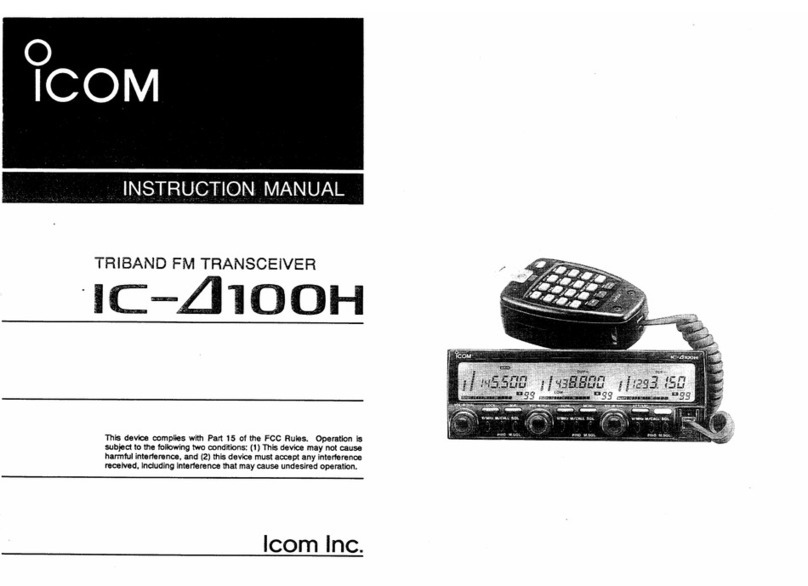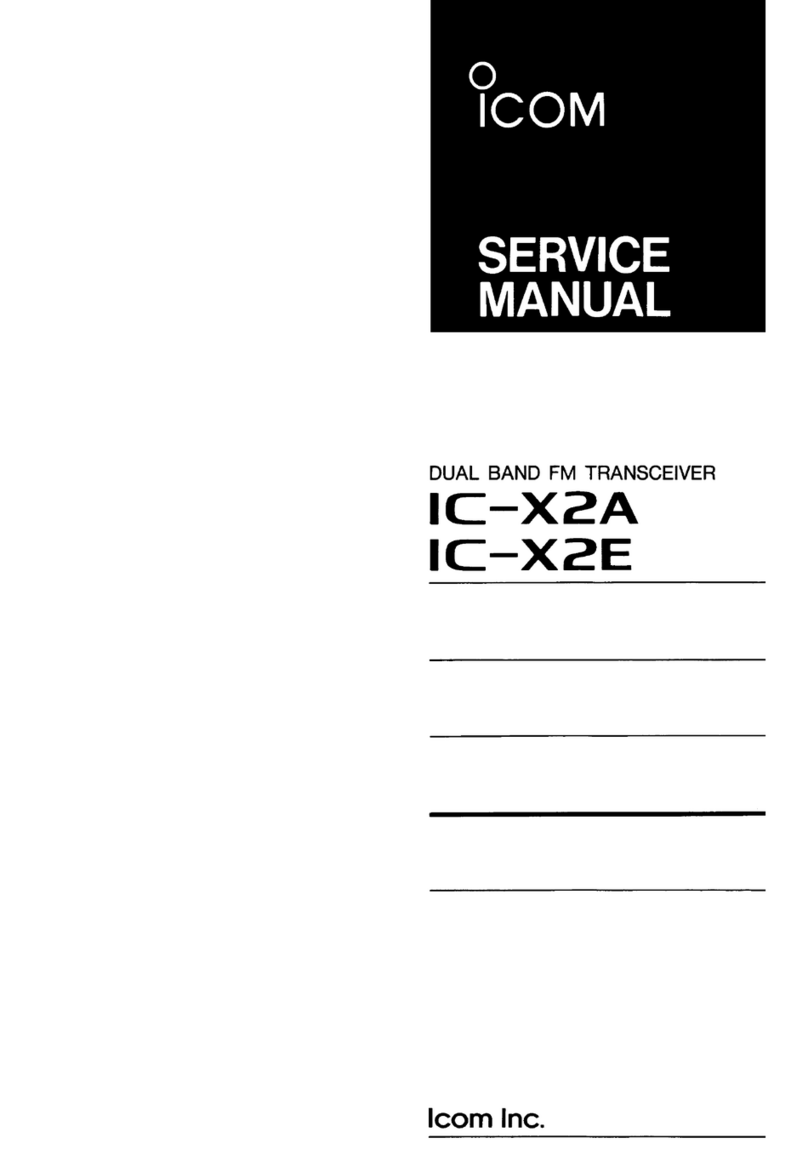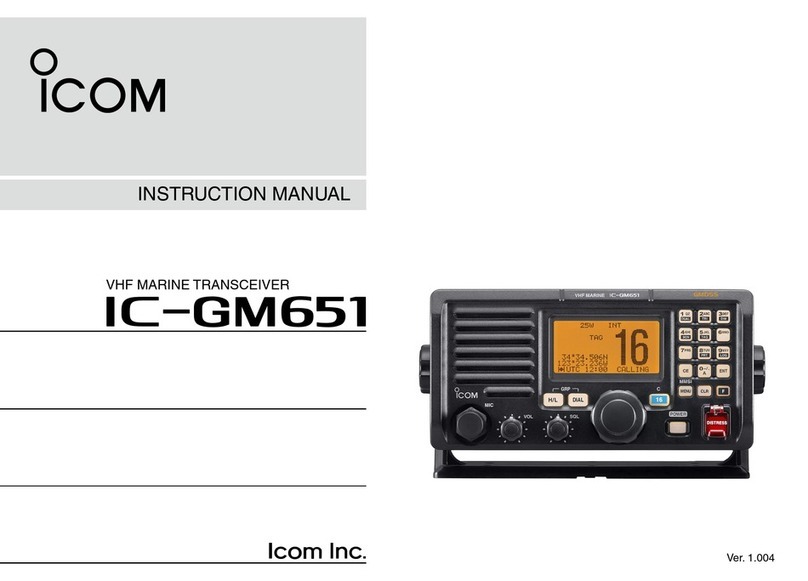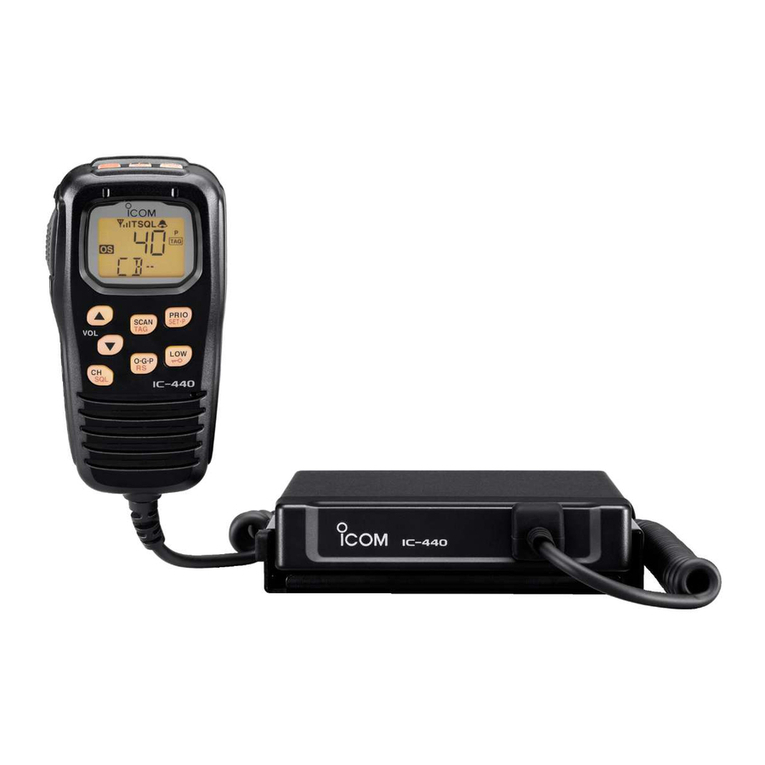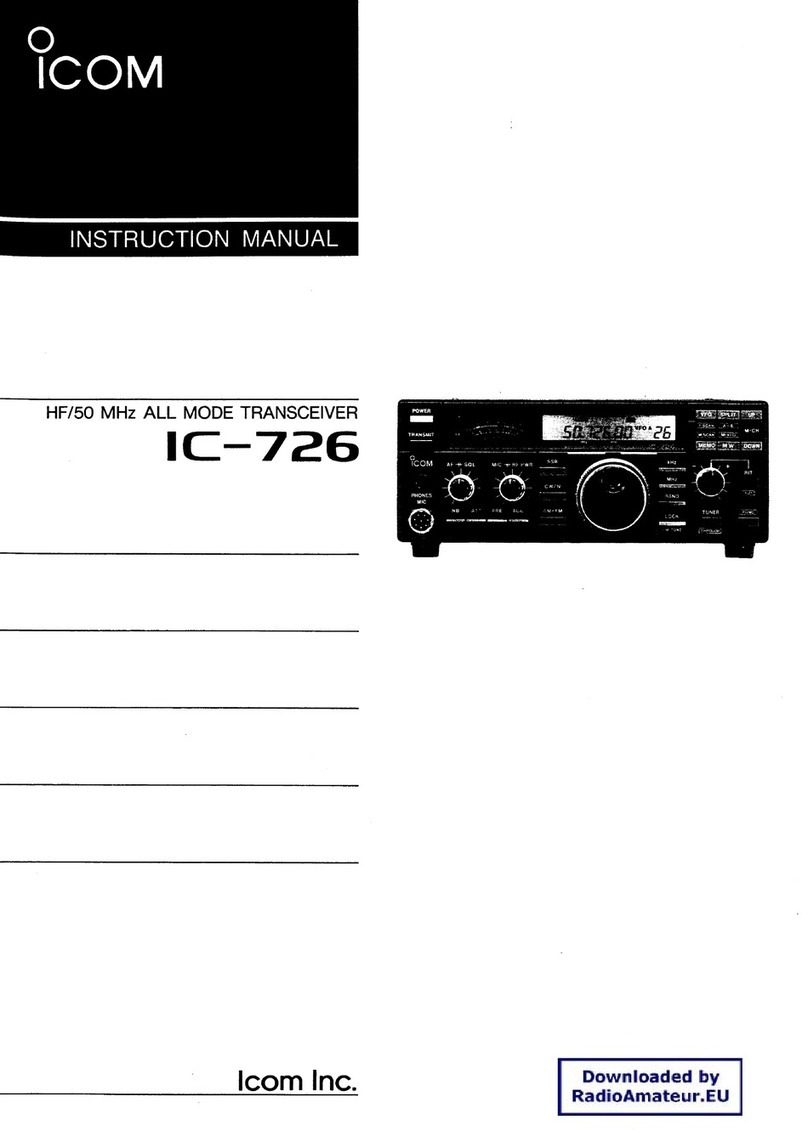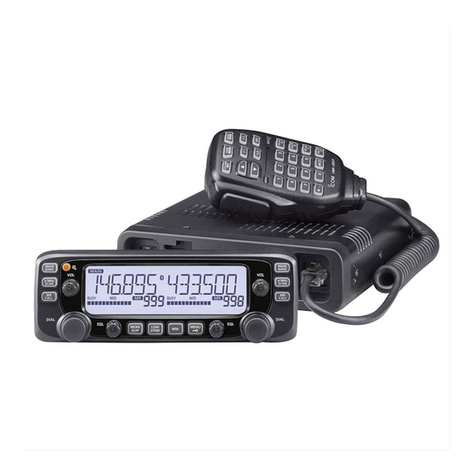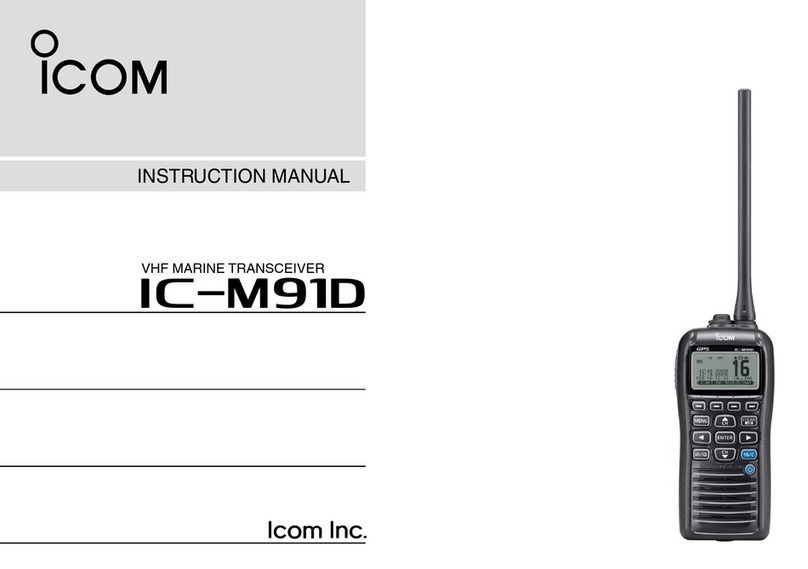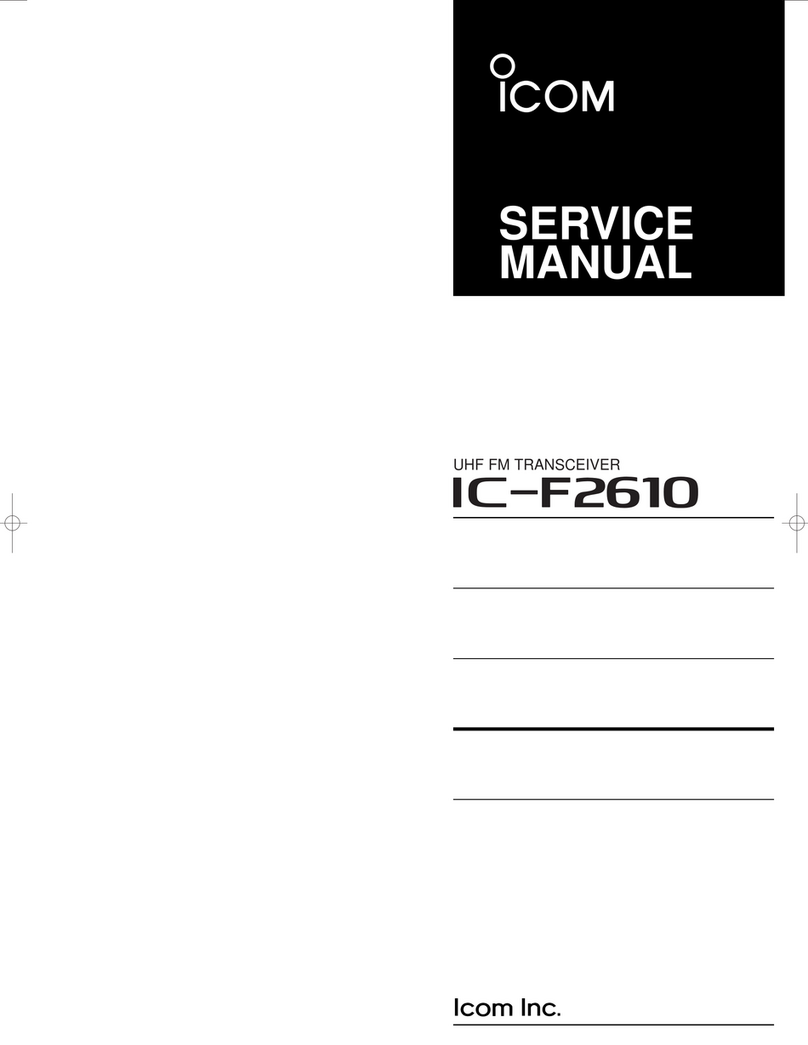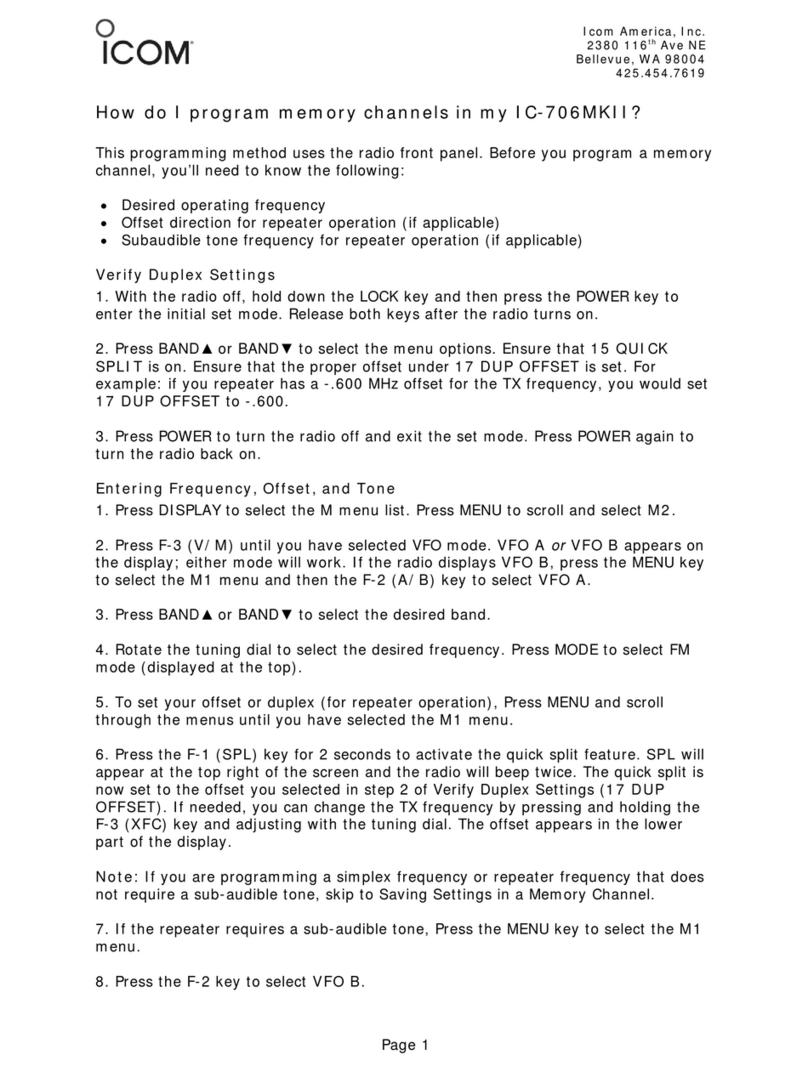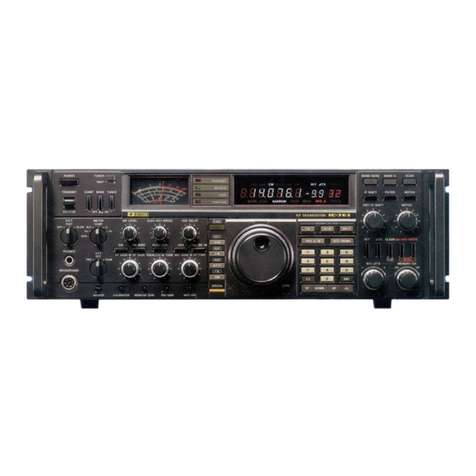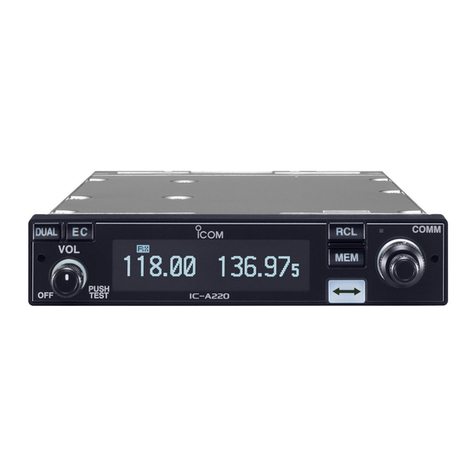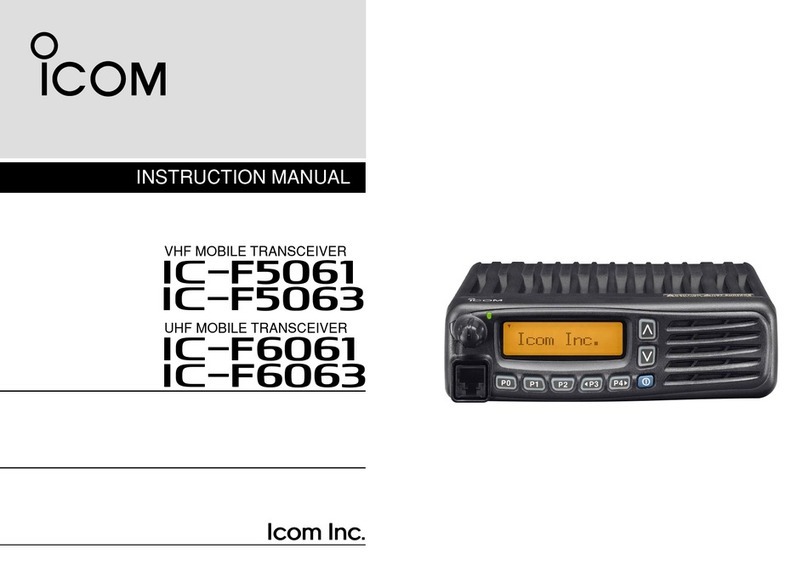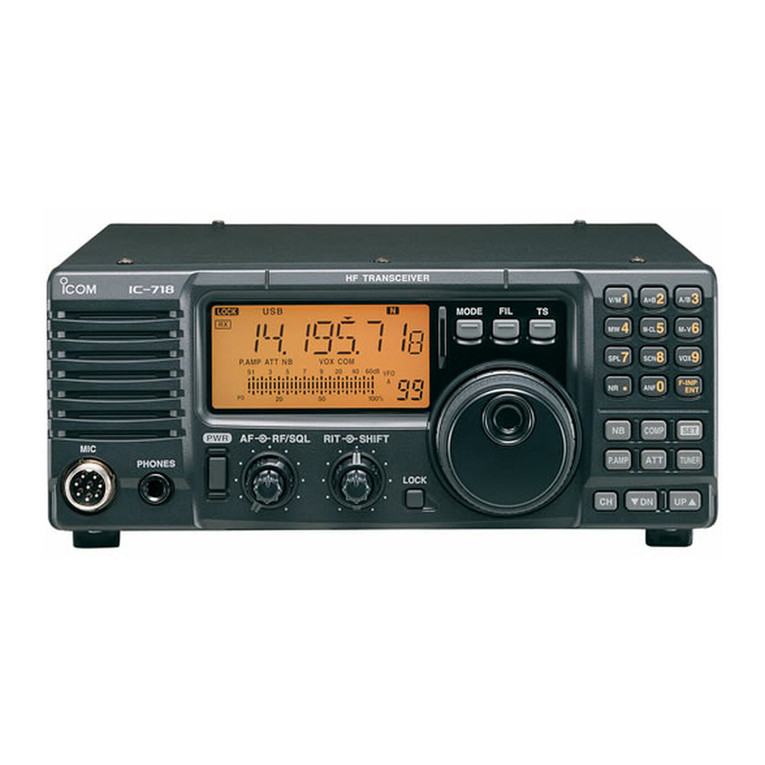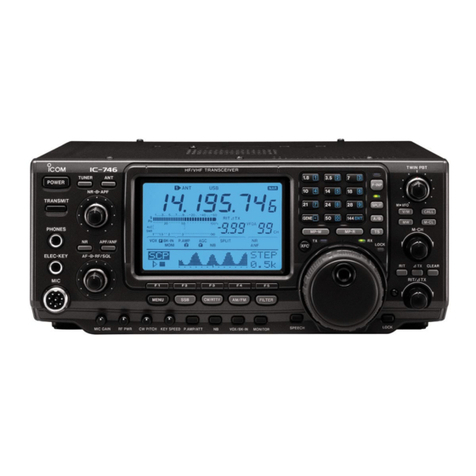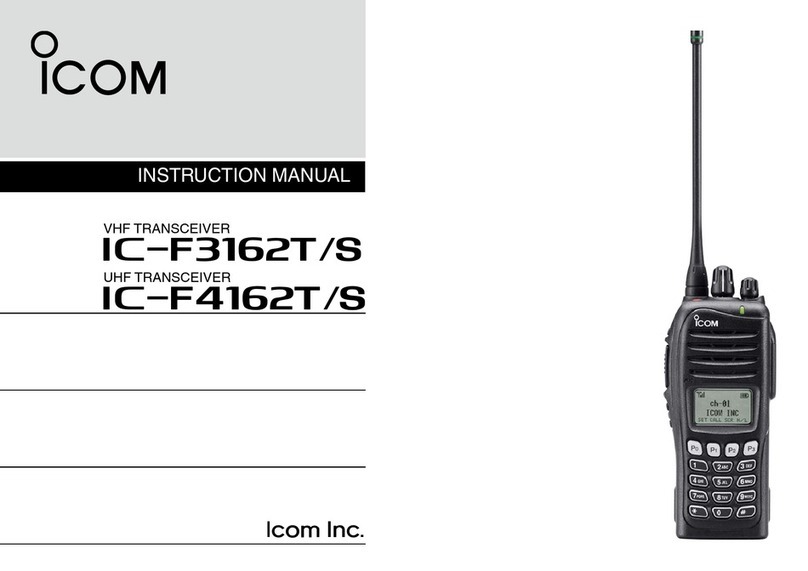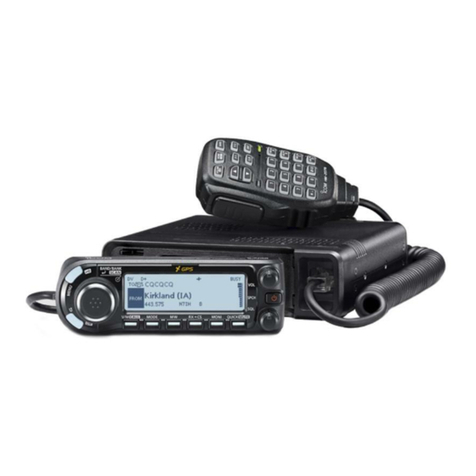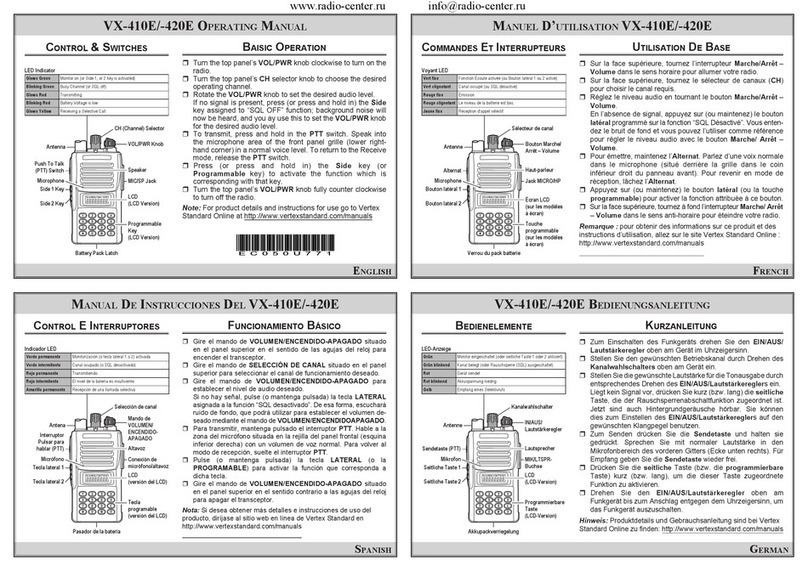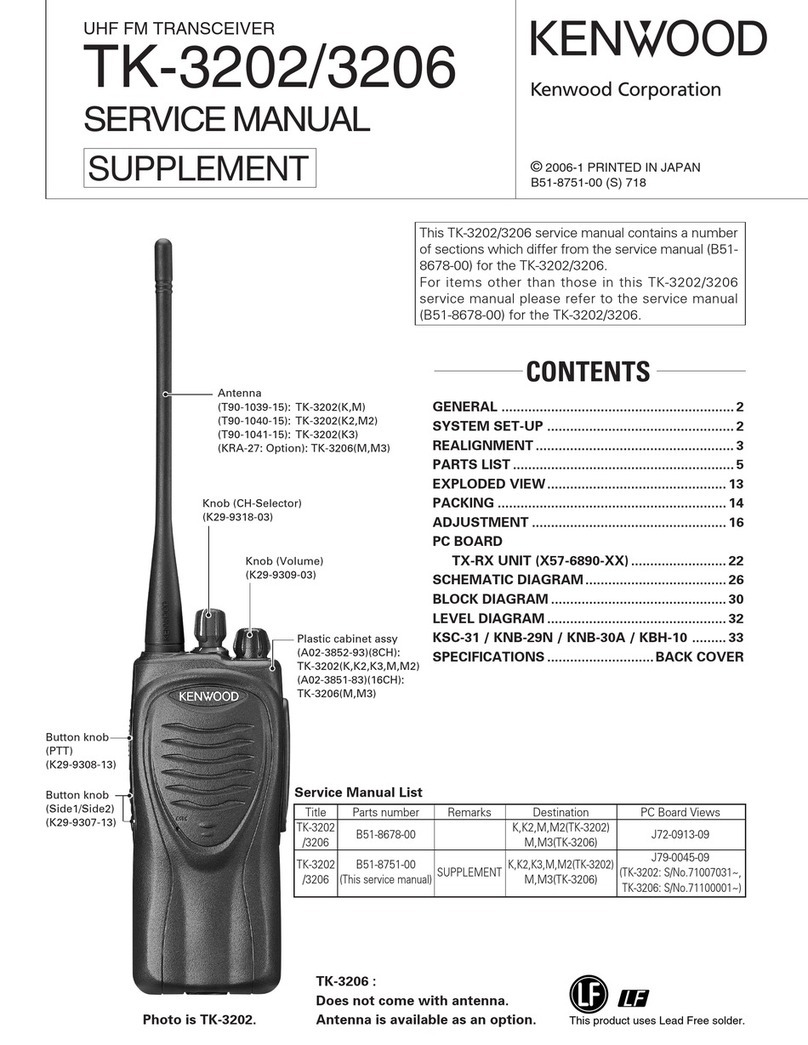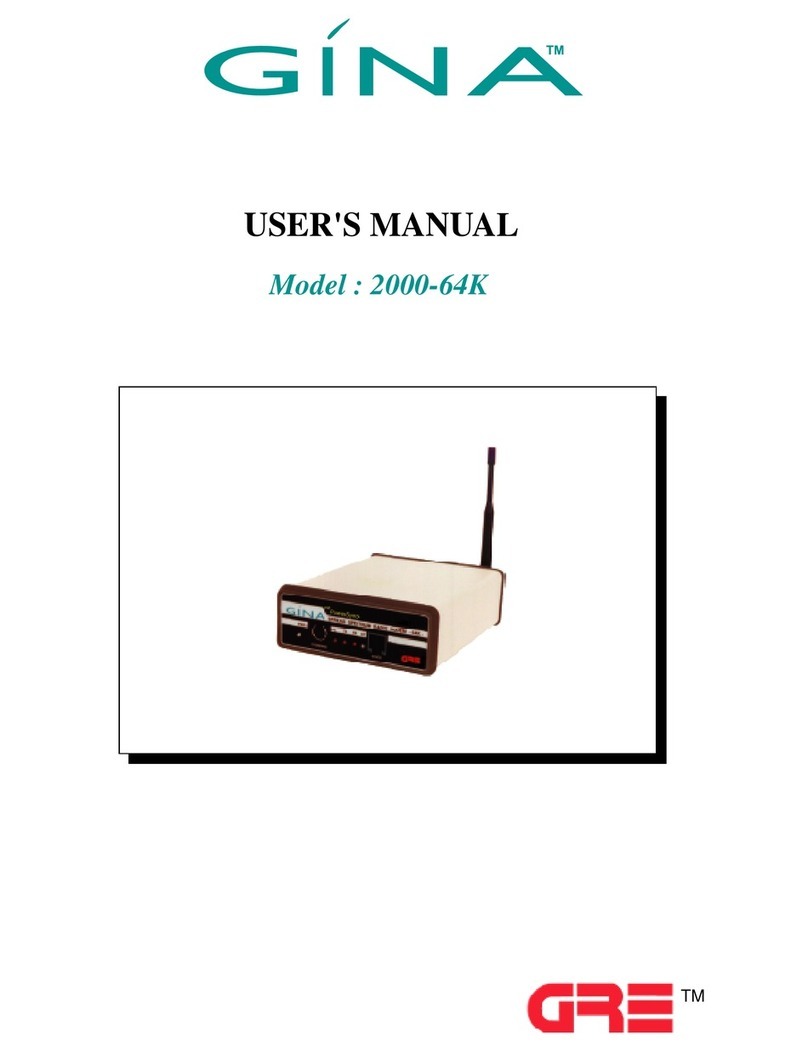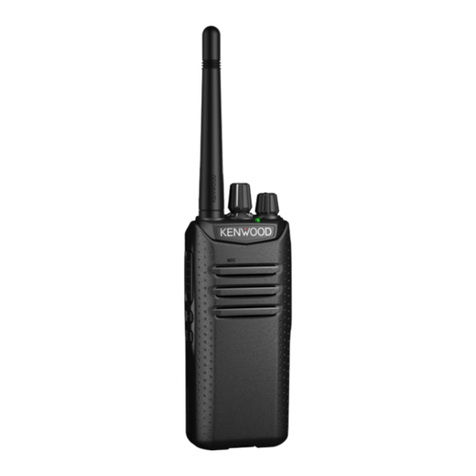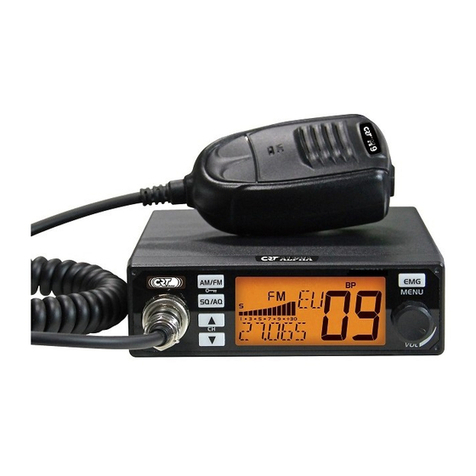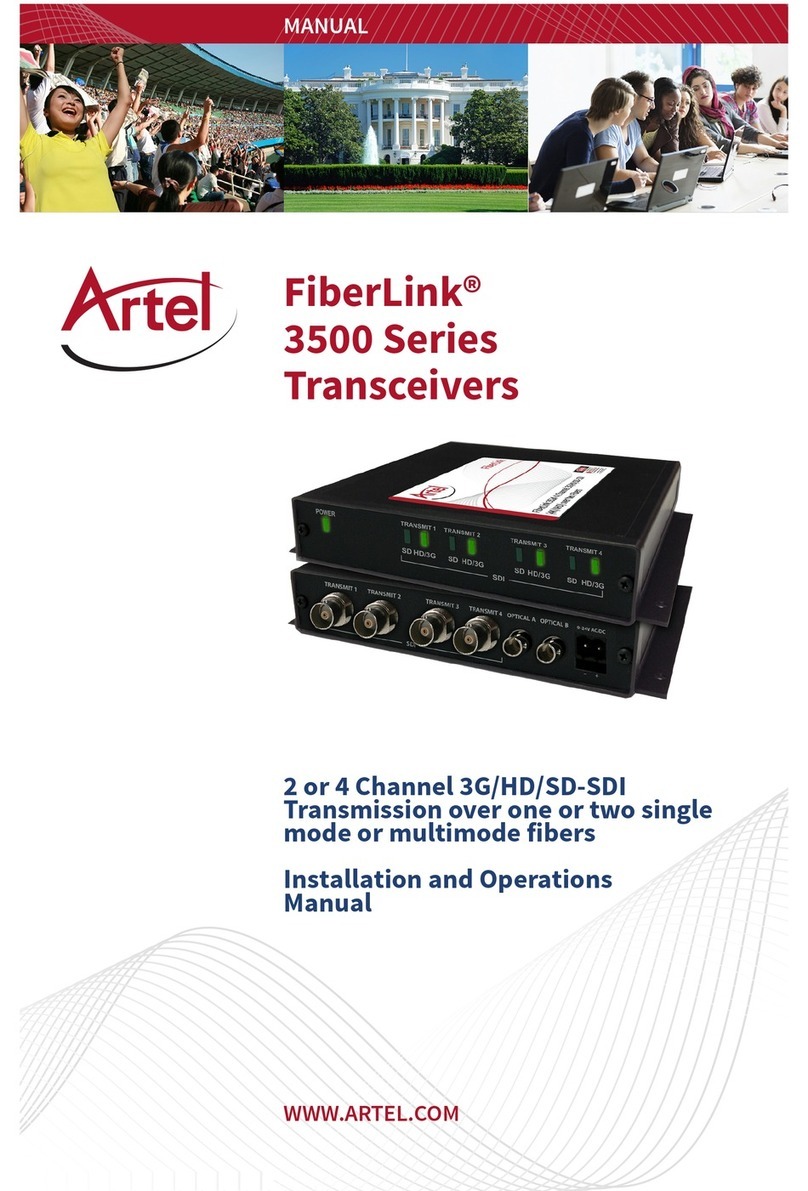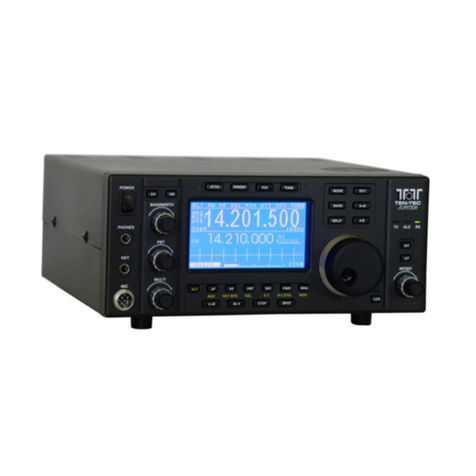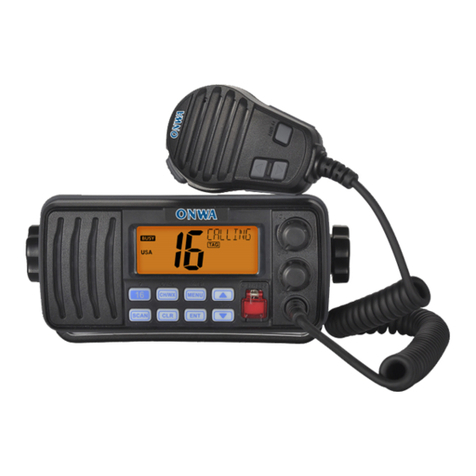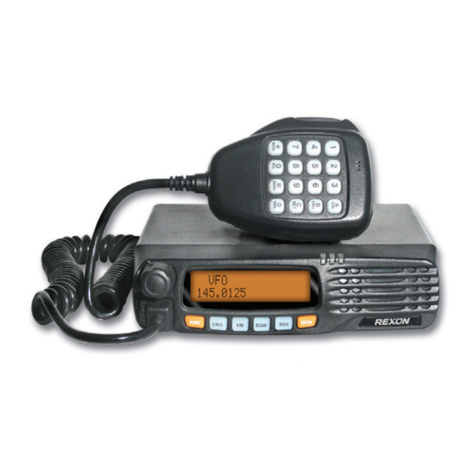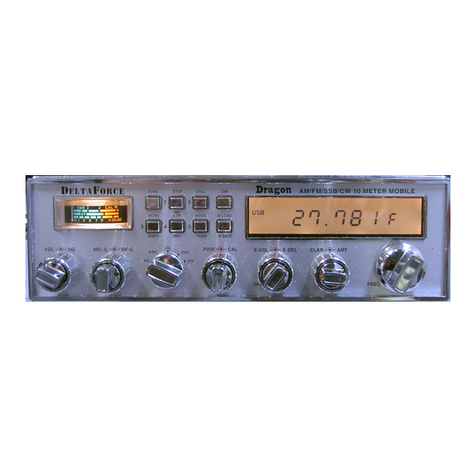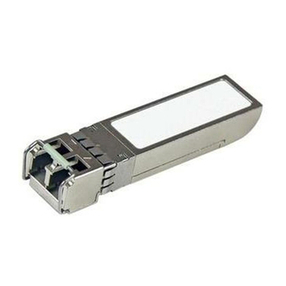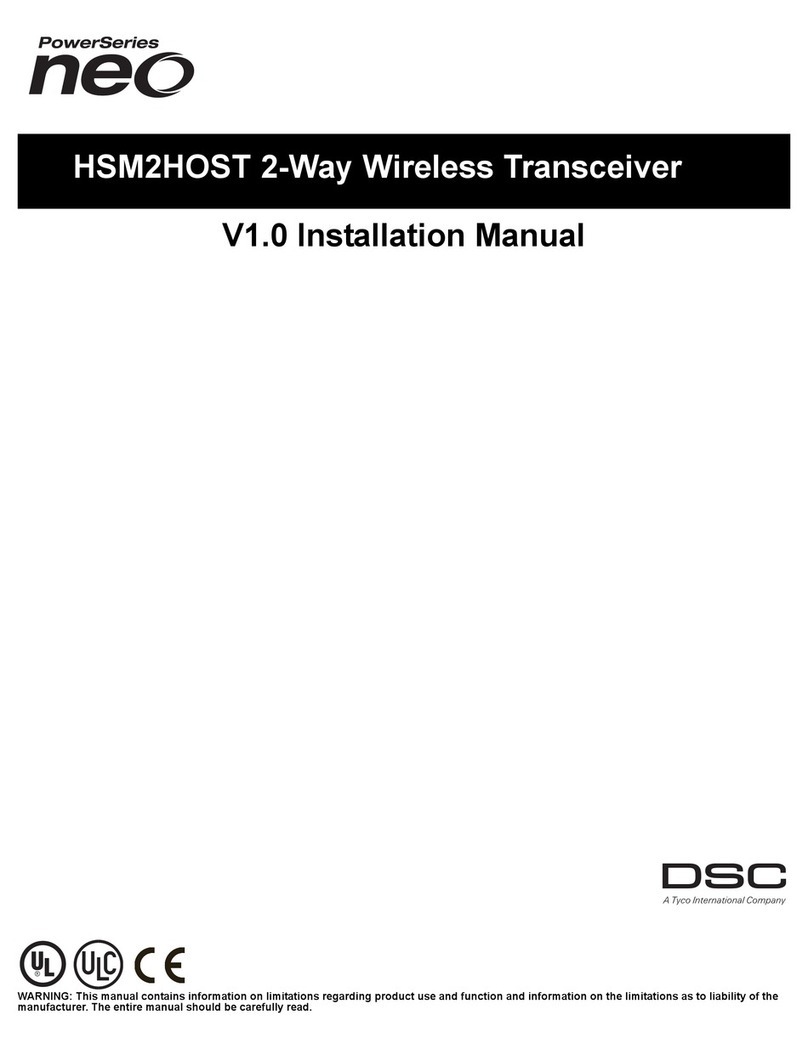Icom IC-M506 User manual

INSTRUCTION MANUAL
iM506
VHF MARINE TRANSCEIVER
This device complies with Part 15 of the FCC
Rules. Operation is subject to the condition that
this device does not cause harmful interference.

i
FOREWORD
Thank you for purchasing this Icom product. The IC-M506
VHF MARINE TRANSCEIVER is designed and built with Icom’s
state of the art technology and craftsmanship. With proper
care, this product should provide you with years of trouble-
free operation.
We appreciate you making the IC-M506 your radio of choice,
and hope you agree with Icom’s philosophy of “technology
first.” Many hours of research and development went into the
design of your IC-M506.
FEATURESD
MBuilt-in Class D DSC
MIntegrated AIS Receiver
MNMEA 2000™ Connectivity
M2 Minutes Last Call Voice Recording
MSuperb Active Noise Cancelling
M25W Two-Way Hailer and Horn
MIPX8 Submersible Plus™
MOptional COMMANDMIC
IV
™ HM-195
IMPORTANT
READ ALL INSTRUCTIONS carefully and completely
before using the transceiver.
SAVE THIS INSTRUCTION MANUAL — This in-
struction manual contains important operating instructions
for the IC-M506.
EXPLICIT DEFINITIONS
WORD DEFINITION
RWARNING! Personal injury, fire hazard or electric
shock may occur.
CAUTION Equipment damage may occur.
NOTE
If disregarded, inconvenience only. No risk
of personal injury, fire or electric shock.
CLEAN THE TRANSCEIVER AND MICROPHONE THOR-
OUGHLY WITH FRESH WATER after exposure to water
including salt, otherwise, the keys and switch may become
inoperable due to salt crystallization.
For Canada:
This device complies with RSS-310 of Industry Canada. Op-
eration is subject to the condition that this device does not
cause harmful interference.
Cet appareil est conforme au CNR-310 d’Industrie Canada.
Son exploitation est autorisee sous reserve que l’appareil ne
cause pas de brouillage prejudiciable.

If your vessel requires assistance, contact other vessels and
the Coast Guard by sending a Distress call on Channel 16.
Or, transmit your Distress call using digital selective calling
on Channel 70.
USING CHANNEL 16
DISTRESS CALL PROCEDURE
1. “MAYDAY MAYDAY MAYDAY.”
2. “THIS IS ...............” (name of vessel).
3. Say your call sign or other description of the vessel
(AND 9 digit DSC ID if you have one).
4. “LOCATED AT ...............” (your position).
5. State the nature of the distress and assistance re-
quired.
6. Give any other information which might facilitate
the rescue.
USING DIGITAL SELECTIVE CALLING (Ch 70)
DISTRESS CALL PROCEDURE
1. While lifting up the key cover, hold down [DIS-
TRESS] for 3 seconds until you hear 3 short beeps
and then one long beep.
2. Wait for an acknowledgment on Channel 70 from a
coast station.
s!FTERTHEACKNOWLEDGEMENTISRECEIVED#HANNELIS
automatically selected.
3. Hold down [PTT], then transmit the appropriate in-
formation as listed above.
ii
IN CASE OF EMERGENCY

iii
RADIO OPERATOR WARNING
WARNING
Icom requires the radio operator to meet the
FCC Requirements for Radio Frequency Expo-
sure. An omnidirectional antenna with gain not
greater than 9 dBi must be mounted a mini-
mum of 5 meters (measured from the lowest
point of the antenna) vertically above the main
deck and all possible personnel. This is the minimum safe
separation distance estimated to meet all RF exposure com-
pliance requirements. This 5 meter distance is based on the
FCC Safe Maximum Permissible Exposure (MPE) distance
of 3 meters added to the height of an adult (2 meters) and is
appropriate for all vessels.
For watercraft without suitable structures, the antenna must
be mounted so as to maintain a minimum of 1 meter verti-
cally between the antenna, (measured from the lowest point
of the antenna), to the heads of all persons AND all persons
must stay outside of the 3 meter MPE radius.
Do not transmit with radio and antenna when persons are
within the MPE radius of the antenna, unless such persons
(such as driver or radio operator) are shielded from antenna
field by a grounded metallic barrier. The MPE Radius is the
minimum distance from the antenna axis that person should
maintain in order to avoid RF exposure higher than the al-
lowable MPE level set by FCC.
FAILURE TO OBSERVE THESE LIMITS MAY ALLOW
THOSE WITHIN THE MPE RADIUS TO EXPERIENCE RF
RADIATION ABSORPTION WHICH EXCEEDS THE FCC
MAXIMUM PERMISSIBLE EXPOSURE (MPE) LIMIT.
IT IS THE RESPONSIBILITY OF THE RADIO OPERATOR
TO ENSURE THAT THE MAXIMUM PERMISSIBLE EXPO-
SURE LIMITS ARE OBSERVED AT ALL TIMES DURING
RADIO TRANSMISSION. THE RADIO OPERATOR IS TO
ENSURE THAT NO BYSTANDERS COME WITHIN THE
RADIUS OF THE MAXIMUM PERMISSIBLE EXPOSURE
LIMITS.
Determining MPE Radius
THE MAXIMUM PERMISSIBLE EXPOSURE (MPE) RA-
DIUS HAS BEEN ESTIMATED TO BE A RADIUS OF
ABOUT 3M PER OET BULLETIN 65 OF THE FCC.
THIS ESTIMATE IS MADE ASSUMING THE MAXIMUM
POWER OF THE RADIO AND ANTENNAS WITH A MAXI-
MUM GAIN OF 9dBi ARE USED FOR A SHIP MOUNTED
SYSTEM.

iv
1
2
3
4
5
6
7
8
9
10
11
12
13
14
15
16
AVERTISSEMENT POUR LES OPÉRATEURS RADIO
Icom exige que l'opérateur radio se conforme aux
exigences de la FCC en matière d'exposition aux
radiofréquences. Une antenne omnidirectionnelle
dont le gain ne dépasse pas 9dBi doit être fixée
à une distance minimale de 5 mètres (mesurée
depuis le point le plus bas de l'antenne) verticale-
ment au-dessus du pont principal et de tout le personnel qui peut
s'y trouver. Il s'agit de la distance de sécurité minimale prévue pour
satisfaire aux exigences de conformité en matière d'exposition aux
RF. Cette distance de 5 mètres est établie en fonction de l'exposition
maximale admissible sécuritaire de 3 mètres établie par la FCC, à
laquelle on ajoute la hauteur d'un adulte (2 mètres); cette distance
convient pour tous les navires.
Dans le cas des embarcations sans structure convenable, l'antenne
doit être fixée de façon à maintenir une distance minimale de 1 mètre
verticalement entre cette antenne (mesurée depuis son point le plus
bas) et la tête de toute personne présente; toutes les personnes
présentes doivent se tenir à l'extérieur d'un rayon d'exposition maxi-
male admissible de 3 mètres.
Ne pas émettre à l'aide de la radio et de l'antenne lorsque des
personnes se trouvent à l'intérieur du rayon d'exposition maximale
admissible de cette antenne, à moins que ces personnes (comme
le conducteur ou l'opérateur radio) ne soient protégées du champ
de l'antenne par un écran métallique relié à la masse. Le rayon
d'exposition maximale admissible équivaut à la distance minimale
que cette personne doit maintenir entre elle et l'axe de l'antenne pour
éviter une exposition aux RF supérieure au niveau d'exposition maxi-
male admissible fixé par la FCC.
LE NON-RESPECT DE CES LIMITES PEUT CAUSER, POUR LES
PERSONNES SITUÉES DANS LE RAYON D'EXPOSITION MAXI-
MALE ADMISSIBLE, UNE ABSORPTION DE RAYONNEMENT DE
RF SUPÉRIEURE À L'EXPOSITION MAXIMALE ADMISSIBLE
FIXÉE PAR LA FCC.
L'OPÉRATEUR RADIO EST RESPONSABLE D'ASSURER QUE
LES LIMITES D'EXPOSITION MAXIMALE ADMISSIBLE SOIENT
RESPECTÉES EN TOUT TEMPS PENDANT LA TRANSMISSION
RADIO. L'OPÉRATEUR RADIO DOIT S'ASSURER QU'AUCUNE
PERSONNE PRÉSENTE NE SE SITUE À L'INTÉRIEUR DU RAY-
ON D'EXPOSITION MAXIMALE ADMISSIBLE.
Établir le rayon d'exposition maximale admissible
ON ESTIME QUE LE RAYON D'EXPOSITION MAXIMALE ADMIS-
SIBLE EST D'ENVIRON 3 M, TEL QUE STIPULÉ DANS LE BUL-
LETIN OET 65 DE LA FCC. CETTE DISTANCE ESTIMÉE TIENT
COMPTE D'UN SYSTÈME INSTALLÉ SUR UN NAVIRE UTILISANT
LA PUISSANCE MAXIMALE DE LA RADIO ET DES ANTENNES
DONT LE GAIN MAXIMAL EST DE 9dBi.
AVERTISSEMENT

v
FCC INFORMATION
s&/2#,!33!5.).4%.4)/.!,2!$)!4/23
This equipment has been tested and found to comply with the
limits for a Class A digital device, pursuant to part 15 of the
FCC Rules. These limits are designed to provide reasonable
protection against harmful interference when the equipment
is operated in a commercial environment. This equipment
generates, uses, and can radiate radio frequency energy
and, if not installed and used in accordance with the instruc-
tion manual, may cause harmful interference to radio com-
munications.
Operation of this equipment in a residential area is likely to
cause harmful interference in which case the user will be re-
quired to correct the interference at his own expense.
NOTE
A WARNING STICKER is supplied with the U.S.A. version
transceiver.
To comply with FCC regulations, this sticker must be affixed in
such a location as to be readily seen from the operating con-
trols of the radio as in the diagram below. Make sure the chosen
location is clean and dry before applying the sticker.
EXAMPLE

vi
PRECAUTIONS
RWARNING! NEVER
connect the transceiver to an AC
outlet. This may pose a fire hazard or result in an electric shock.
RWARNING! NEVER connect the transceiver to a pow-
er source of more than 13V DC or use reverse polarity. This
will ruin the transceiver.
RWARNING! NEVER cut the DC power cable between
the DC plug at the back of the transceiver and fuse holder. If
an incorrect connection is made after cutting, the transceiver
may be damaged.
#!54)/. .%6%2
place the transceiver where normal
operation of the vessel may be hindered or where it could
cause bodily injury.
KEEP the transceiver and microphone at least 1 m away
from the vessel’s magnetic navigation compass.
DO NOT use or place the transceiver in areas with tem-
peratures below –20°C (–4°F) or above +60°C (+140°F) or, in
areas subject to direct sunlight, such as the dashboard.
DO NOT use harsh solvents such as benzine or alcohol to
clean the transceiver, as they will damage the transceiver’s
surfaces. If the transceiver becomes dusty or dirty, wipe it
clean with a soft, dry cloth.
DO NOT disassemble or modify the transceiver for any rea-
son.
BE CAREFUL! The transceiver rear panel will become
hot when operating continuously for long periods of time.
Place the transceiver in a secure place to avoid inadvertent
use by children.
BE CAREFUL! The transceiver meet IPX8 requirements
and the optional HM-195 COMMANDMICIV™meet IPX7 re-
quirements for waterproof protection. However, once the
transceiver has been dropped, waterproof protection cannot
be guaranteed because of possible damage to the transceiv-
er’s case or the waterproof seal.
* Except for the DC power connector, NMEA In/Out leads and AF
Out leads.
For U.S.A. only
#!54)/. Changes or modifications to this device, not ex-
pressly approved by Icom Inc., could void your authority to
operate this device under FCC regulations.
Icom, Icom Inc. and the Icom logo are registered trademarks of Icom Incor-
porated (Japan) in Japan, the United States, the United Kingdom, Germany,
France, Spain, Russia and/or other countries.
COMMANDMIC is a registered trademark of Icom Incorporated (Japan) in Ja-
pan and the United States.

vii
TABLE OF CONTENTS
FOREWORD .........................................................................i
IMPORTANT..........................................................................i
EXPLICIT DEFINITIONS....................................................... i
IN CASE OF EMERGENCY................................................. ii
RADIO OPERATOR WARNING .......................................... iii
AVERTISSEMENT POUR LES OPÉRATEURS RADIO...... iv
FCC INFORMATION ............................................................ v
NOTE....................................................................................v
PRECAUTIONS................................................................... vi
TABLE OF CONTENTS...................................................... vii
1 OPERATING RULES.......................................................1
2 PANEL DESCRIPTION.................................................2-7
Front panelN...................................................................2
Function displayN...........................................................5
Speaker MicrophoneN....................................................7
Soft key functionN...........................................................7
3 PREPARATION................................................................8
MMSI code programmingN.............................................8
4 BASIC OPERATION...................................................9-15
Channel selectionN........................................................9
Receiving and transmittingN.........................................11
Call channel programmingN.........................................13
Channel name programmingN......................................13
Microphone Lock functionN..........................................14
Adjusting the display back-light levelN..........................15
AquaQuake water draining functionN...........................15
5 SCAN OPERATION..................................................16-17
Scan typesN.................................................................16
Setting Favorite channelsN...........................................17
Starting a scanN...........................................................17
6 DUALWATCH/TRI-WATCH............................................18
DescriptionN.................................................................18
OperationN...................................................................18
7 DSC OPERATION ....................................................19-73
DSC address IDN........................................................19
Position and time programmingN..................................22
Distress callN................................................................23
Transmitting DSC callsN...............................................28
Receiving DSC callsN..................................................53
Received Call logN.......................................................65
Transmitted Call logN....................................................67
DSC SettingsN.............................................................68
Making an Individual call using an AIS transponderN..72
8 OTHER FUNCTIONS................................................74-78
Intercom operationN.....................................................74
RX Speaker functionN..................................................75
Hailer operationN..........................................................75
Horn functionN..............................................................76

viii
1
2
3
4
5
6
7
8
9
10
11
12
13
14
15
16
Voice scrambler operationN........................................78
Voice recorder functionN..............................................78
9 AIS Receiver (Depending on versions).................79-88
About AISN...................................................................79
AIS ClassesN...............................................................79
Function displayN.........................................................80
About the detail screenN..............................................83
AIS SettingsN...............................................................87
10 NMEA 2000 Connection (Depending on versions)....89
DescriptionN.................................................................89
11 MENU SCREEN OPERATION ...............................91-100
Menu screen operationN..............................................91
Menu screen itemsN.....................................................92
Configuration itemsN....................................................93
Radio Settings itemsN..................................................97
12 CONNECTIONS AND MAINTENANCE...............101-107
ConnectionsN.............................................................101
AntennaN....................................................................103
Fuse replacementN....................................................103
CleaningN...................................................................103
Supplied accessoriesN...............................................103
Mounting the transceiverN..........................................104
MB-132 installationN..................................................105
Microphone installationN............................................106
13 SPECIFICATIONS AND OPTIONS ......................108-109
SpecificationsN...........................................................108
OptionsN.....................................................................109
14 CHANNEL LIST...........................................................110
15 TROUBLESHOOTING.................................................111
16 TEMPLATE ..................................................................112

1
OPERATING RULES
1
DPriorities
s2EADALLRULES AND REGULATIONS PERTAINING TO CALL PRIORITIES
and keep an up-to-date copy handy. Safety and distress
calls take priority over all others.
s9OUMUSTMONITOR#HANNELWHENYOUARENOTOPERATING
on another channel.
s&ALSEORFRAUDULENTDISTRESSCALLSAREPROHIBITEDUNDERLAW
PrivacyD
s)NFORMATIONOVERHEARDBUTNOTINTENDEDFORYOUCANNOTLAW-
fully be used in any way.
s)NDECENTORPROFANELANGUAGEISPROHIBITED
Radio licensesD
(1) SHIP STATION LICENSE
You may require a current radio station license before using
the transceiver. It is unlawful to operate a ship station which is
not licensed, but required to be.
If required, contact your dealer or the appropriate govern-
ment agency for a Ship-Radiotelephone license application.
This government-issued license states the call sign which is
your craft’s identification for radio purposes.
(2) OPERATOR’S LICENSE
A Restricted Radiotelephone Operator Permit is the license
most often held by small vessel radio operators when a radio
is not required for safety purposes.
If required, the Restricted Radiotelephone Operator Permit
must be posted or kept with the operator. If required, only a
licensed radio operator may operate a transceiver.
However, non-licensed individuals may talk over a transceiver
if a licensed operator starts, supervises, ends the call and
makes the necessary log entries.
A current copy of the applicable government rules and regu-
lations is only required to be on hand for vessels in which
a radio telephone is compulsory. However, even if you are
not required to have these on hand it is your responsibility to
be thoroughly acquainted with all pertinent rules and regula-
tions.
./4%Even though the transceiver is capable of opera-
tion on VHF marine channels 3, 21, 23, 61, 64, 81, 82 and
83, according to FCC regulations these simplex channels
cannot be lawfully used by the general population in USA
waters.

2
2
PANEL DESCRIPTION
1
2
3
4
5
6
7
8
9
10
11
12
13
14
15
16
Front panelN
qDISTRESS KEY [DISTRESS] (pp. 23, 24)
Hold down for 3 seconds to transmit a Distress call.
wENTER KEY [ENT]
Push to set the input data, selected item, and so on.
eLEFT AND RIGHT KEYS [Ω]/[≈]
Push to switch to the previous or next key function that±
is assigned to the soft keys. (p. 7)
Push to select the desired character or number in the±
table while in the channel name, position, MMSI code
programming mode, and so on. (pp. 8, 13, 22)
r
UP AND DOWN/CHANNEL SELECT KEYS [∫CH]/[√CH]
Push to select the operating channels, Menu items,±
Menu settings, and so on.
While scanning, push to check Favorite channels,±
change the scanning direction or manually resume a
scan. (p. 16)
tCLEAR KEY [CLEAR]
Push to cancel the entered data, or to return to the previ-
ous screen.
yMENU KEY [MENU]
(p.
91
)
Push to enter or exit the Menu screen.
uDIAL/POWER SWITCH [PWR]
When the power is OFF, hold down for 1 second to turn±
ON power. (p. 11)
±Hold down for 1 second to turn OFF power.
±Rotate to select the operating channels, Menu items,
Menu settings, and so on.
±Push to set the input data, selected item, and so on..
iCHANNEL 16/CALL CHANNEL KEY [16/C]
±Push to select Channel 16. (p. 9)
±Hold down for 1 second to select the Call channel. (p.
9
)
sh#!,,vAPPEARSWHENTHE#ALLCHANNELISSELECTED
CLEARMENU
ENT
CH
CH
t
u
y
we
r
i
q
o
!0!1
Function display (p. 5)
Speaker

3
2PANEL DESCRIPTION
CLEARMENU
ENT
CH
CH
t
u
y
we
r
i
q
o
!0!1
Function display (p. 5)
Speaker
oSQUELCH DIAL
Rotate to adjust the squelch level.
!0 SOFT KEYS
Desired functions as described below can be assigned in
the Menu screen.
Scan [ ](p. 17)
Push to start or stop a Normal or Priority scan.
Dualwatch/Tri-watch [ ](p. 18)
Push to start a Dualwatch or Tri-watch.±
Push to stop a Dualwatch or Tri-watch when either is±
activated.
AIS [ ](p. 86)
Push to display AIS plotter on the left side of screen.
Channel/Weather channel [ ]* (pp. 9, 11)
Push to selects and toggles the regular channel and
Weather channel.
High/Low [ ](p. 11)
Push to set the power to high or low.
s3OMECHANNELSARESETTOONLYLOWPOWER
SCBL [ ](p. 78)
Push to turn the Voice Scrambler ON or OFF.
s4HE)CONAPPEARSWHENTHEVOICESCRAMBLERIS/.
PLAY [ ](p. 78)
Push to enter voice recoder menu.
sh2%#v)CONBLINKSWHENTHERECORDERIS/.
RX Speaker [ ] (p. 75)
Push to turn the RX Speaker mode ON or OFF.
LO/DX [ ]* (p. 11)
Push to turn the Attenuator function ON or OFF.
sh,/#vAPPEARSWHENTHE!TTENUATORFUNCTIONIS/.
Favorite channel [ ] (p. 17)
Push to set or clear the displayed channel as a Favorite±
(Tag) channel.
±Hold down for 3 seconds to clear or set all Favorite
channels in the selected channel group.

4
2
PANEL DESCRIPTION
1
2
3
4
5
6
7
8
9
10
11
12
13
14
15
16
Name [ ](p. 13)
Push to enter the channel name programming mode.
Backlight [ ](p. 15)
Push to enter the LCD and key backlight brightness ad-
justment mode.
s7HILEINTHEADJUSTMENTMODEPUSH;∫]/[√]/[Ω]/[≈] or rotate Dial
to adjust the brightness of the LCD and key backlight.
Log [ ](p. 65)
Push to enter “RCVD CALL LOG” in the DSC CALLS menu.
!1 VOLUME DIAL
Rotate to adjust the volume level.

5
2PANEL DESCRIPTION
Function displayN
qBUSY/TRANSMIT ICON (p. 11)
“±” appears when receiving a signal or when the
squelch is open.
“±” appears while transmitting.
wPOWER ICON (p. 11)
“25W” appears when high power is selected.±
“1W” appears when low power is selected.±
eRX SPEAKER ICON (p. 75)
Appears while in the RX Speaker mode.
rCHANNEL GROUP ICON (p. 10)
A selected channel group icon, U.S.A. “USA,” Interna-±
tional “INT” or Canadian “CAN” appears, depending on
the transceiver version.
“WX” appears when the weather channel is selected.±
tCALL CHANNEL ICON (p. 9)
Appears when the Call channel is selected.
yDUPLEX ICON (p. 10)
Appears when a duplex channel is selected.
uFAVORITE CHANNEL ICON (p. 18)
Appears when a Favorite (Tag) channel is selected.
iMESSAGE ICON
Blinks when there is an unread DSC message.
oGPS ICON
Stays ON when the GPS receiver is activated and valid±
position data is received.
Blinks when invalid position data is being received.±
!0 SWITCH ICON (p. 69)
Appears when the “CH 16 SWITCH” in DSC Settings is set
to ‘OFF.’
!1 LOW BATTERY ICON
Blinks when the battery voltage drops to approximately
13 V DC or less.
!4
!6
!7
!5
qwi
et
r!0
you
!1
!2
!3
!8
!9
@0

6
2
PANEL DESCRIPTION
1
2
3
4
5
6
7
8
9
10
11
12
13
14
15
16
!2 CHANNEL NUMBER READOUT
Shows the selected operating channel number.
s7HENASIMPLEXCHANNELISSELECTEDh!vAPPEARS
!3 CHANNEL NAME FIELD
The channel name appears, if programmed. (p. 13)
!4 KEY ICON (p. 7)
Shows the programmed function of the soft keys on the
front panel.
!5 TIME ZONE INDICATOR
Shows the current time when a GPS receiver is con-±
nected, or the time is manually programmed.
s7HEN THE '03 CURRENT TIME IS INVALID hv WILL BLINK EVERY
2 seconds instead of the current time. After 23.5 hours has
passed, “NO TIME” will appear.
shv
will
blink every 2 seconds instead of the current time,
after 4 hours have passed from when the time was manually
programmed.The manually programmed time is held for only
23.5 hours, and after that, “NO TIME” will appear.
“LOCAL” appears when the offset time is set.±
“MNL” appears when±
the time is manually programmed
.
“UTC” appears when±
the GGA, GLL or GNS GPS sen-
tence format is included in the GPS signal.
The date information appears when±
the RMC GPS sen-
tence format is included in the GPS signal.
“NO TIME” appears when no GPS receiver is connect-±
ed, and no time is manually input.
!6 POSITION INDICATOR
± Shows the current position when a GPS receiver is
connected, or the position is manually programmed.
s7HENTHE'03POSITIONISINVALIDhvMAYBLINKEVERYSEC-
onds instead of position. The last position is held for only
23.5 hours, and after that, “NO POSITION” will appear.
s
hvWILLBLINKEVERYSECONDSINSTEADOFPOSITIONAFTERHOURS
have passed from when the position is manually programmed.
The manually programmed position is held for only 23.5 hours,
and after that, “NO POSITION” will appear.
± “NO POSITION” appears when no GPS receiver is
connected, and no position is manually input.
!7 COURSE INDICATOR
Shows the course of your vessel.
!8 SPEED INDICATOR
Shows the speed of your vessel.
!9 SCAN INDICATOR
“SCAN 16” appears during a Priority scan; “SCAN” ap-±
pears during a Normal scan. (p. 17)
“DUAL 16” appears during Dualwatch;“TRI 16” appears±
during Tri-watch. (p. 18)
@0 LOCAL ICON (p. 11)
Appears when the Attenuator function is turned ON.

7
2PANEL DESCRIPTION
Speaker MicrophoneN
Microphone
Speaker
w
q
e
r
qPTT SWITCH [PTT]
Hold down to transmit, release to receive. (pp. 11, 12)
wCHANNEL UP/DOWN KEYS [Y]/[Z]
Push either key to check favorite channels, change scan-
ning direction or manually resumes a scan. (pp. 11, 18)
eTRANSMIT POWER KEY [HI/LO]
±Push to toggle the power high or low. (p. 11)
s3OMECHANNELSARESETTOONLYLOWPOWER
±While holding down [HI/LO], turn ON the power to turn
the Microphone Lock function ON or OFF. (p. 14)
rCHANNEL 16/CALL CHANNEL KEY [16/C]
±Push to select Channel 16. (p. 9)
±Hold down for 1 second to select the Call channel. (p.
9
)
sh#!,,vAPPEARSWHENTHE#ALLCHANNELISSELECTED
Soft key functionN
Various functions can be assigned to the soft keys. When a
key function is assigned, the key icon is displayed above the
soft key, as shown below. Consult your Icom dealer for de-
tails concerning which functions are pre-programmed into the
keys.
Soft keys are also used for select the icon in the menu screen.
(p. 91)
Soft key function selectionD
When “±Ω” or “≈” is displayed beside the key icon, pushing
[Ω] or [≈] sequentially shows the previous or next group of
key functions that is assigned to the soft key.
Push Push
*
*Push this key to start
and stop scan.
The order of the key icons may differ, depending on the
preprogramming.

8
3
PREPARATION
1
2
3
4
5
6
7
8
9
10
11
12
13
14
15
16
MMSI code programmingN
The 9 digit MMSI (Maritime Mobile Service Identity: DSC self
ID) code can be programmed at power ON.
This initial code setting can be performed only once.
After being set, it can be changed by only your dealer
or distributor. If your MMSI code has already been pro-
grammed, this programming is not necessary.
Hold down [PWR](Dial) to turn ON the power.q
s4HREESHORTBEEPSSOUNDANDh./$3#--3)vISDISPLAYED
Push [ENT] to start the MMSI code programming.w
s0USH;#,%!2=TWICETOCANCELTHEPROGRAMMINGANDGOTOTHE
normal operating screen. In this case, the transceiver cannot
make a DSC call. To program the MMSI code, turn OFF the
power, then turn it ON again.
Enter your MMSI code in the following manner:e
s3ELECTADESIREDNUMBERUSING$IALOR;∫]/[√]/[Ω]/[≈].
s0USH;%.4=OR$IALTOSETIT
s4OMOVETHECURSORSELECTEITHERARROWh←” or “→,” then push
[ENT] or Dial.
Repeat stepreto enter all 9 digits.
After entering the 9 digit code, “FINISH” is automaticallyt
selected, and then push [ENT] or Dial to set it.
The “MMSI CONFIRMATION” screen is displayed.y
Enter your MMSI code again for confirmation.u
s%NTERINTHESAMEMANNERASSTEPSethrough t.
When your MMSI code programming is successfully com-i
pleted, the screen as shown below is briefly displayed.
s!FTERTHATTHENORMALOPERATINGSCREENISDISPLAYED
The programmed MMSI code can be checked in the MENU
screen. (p. 92)

9
BASIC OPERATION
4
9
Channel selectionN
Channel 16D
Channel 16 is the distress and safety channel. It is used for
establishing initial contact with a station and for emergency
communications. Channel 16 is automatically monitored dur-
ing both Dualwatch and Tri-watch. While standing by, you
must monitor Channel 16.
±Push [16/C] to select Channel 16.
Push [CH/WX]* to return to the screen displayed before you±
selected Channel 16, or push [∫](CH) or [√](CH) to select
an operating channel.
Call channelD
Each regular channel group has a separate leisure use Call
channel. The Call channels can be programmed, and are
used to store your most often used channel in each channel
group, for quick recall. The Call channel is monitored during
Tri-watch. (p. 13)
Hold down [16/C] for 1 second to select the Call channel of±
the selected channel group.
sh#!,,vANDTHE#ALLCHANNELNUMBERAPPEAR
s%ACHCHANNELGROUPHASANINDEPENDENTCALLCHANNELAFTERPRO-
gramming. (p. 13)
Push [CH/WX]* to return to the screen displayed before you±
selected Call channel, or push [∫](CH) or [√](CH) to select
an operating channel.

10
4
BASIC OPERATION
1
2
3
4
5
6
7
8
9
10
11
12
13
14
15
16
Channel group selectionD
There are preprogrammed U.S.A. channels, International
channels and Canadian channels. These channel groups
may be specified for the operating area.
qPush [MENU].
wRotate Dial or push [∫]/[√] to select “Radio Settings,” and
then push [ENT].
eRotate Dial or push [∫]/[√] to select “CHAN Group,” and
then push [ENT].
rRotate Dial or push [∫]/[√] to select the desired channel
group, and then push [ENT].
s53!53!)NTERNATIONAL).4AND#ANADIAN#!.CHANNEL
groups can be selected.
tPush [EXIT] to exit the Menu screen.
yPush [∫](CH) or [√](CH) to select a channel.
s0USHING;Y]/[Z]on the microphone selects only Favorite chan-
nels.
sh$50vAPPEARSWHENADUPLEXCHANNELISSELECTED
sh!vAPPEARSWHENASIMPLEXCHANNELISSELECTED
When the International
channel group is selected.
Channel group icon appears

11
4BASIC OPERATION
DWeather channels
The transceiver has 10 weather channels.These are used for
monitoring broadcasts from NOAA (National Oceanographic
and Atmospheric Administration.)
The transceiver can automatically detect a weather alert tone
on the selected weather channel or while scanning. (p. 16)
Push [CH/WX] once or twice to select a weather channel.q
sh78vAPPEARSWHENAWEATHERCHANNELISSELECTED
sh78 ” appears when the Weather Alert function is in turned
ON. (p. 78)
Push [w∫](CH) or [√](CH) to select a channel.
s0USHING;Y]/[Z]on the microphone selects only Favorite chan-
nels.
When weather alert is OFF. When weather alert is ON.
Receiving and transmittingN
#!54)/. Transmitting without an antenna will damage
the transceiver.
Hold down [PWR](Dial) to turn ON the power.q
Set the audio and squelch levels. (p. 15)w
First, open the squelch. Then, adjust the audio output±
level. After that, adjust the squelch level until the noise
just disappears.
Change the channel group. (p. 10)e
Push [r∫](CH) or [√](CH) to select a channel. (pp. 9, 10)
s0USHING;Y]/[Z]on the microphone selects only Favorite chan-
nels.
s7HENRECEIVINGASIGNALh ” appears and audio is heard.
s&URTHERADJUSTMENTOFTHEVOLUMELEVELMAYBENECESSARY
Push [LO/DX] to turn the receive Attenuator function ONt
or OFF, if necessary.
s/NLY53!AND!USTRALIANVERSIONTRANSCEIVERS
sh,/#vAPPEARSWHENTHERECEIVE!TTENUATORFUNCTIONIS/.
Push [HI/LO] to select the output power, if necessary.y
sh7vAPPEARSWHENHIGHPOWERISSELECTEDANDh7vAPPEARS
when low power is selected.
s#HOOSELOWPOWERFORSHORTRANGECOMMUNICATIONSCHOOSEHIGH
power for longer distance communications.
s3OMECHANNELSAREFORONLYLOWPOWER
uHold down [PTT] to transmit, then speak at your normal
voice level.
sh ” appears.
s#HANNELCANNOTBEUSEDFORTRANSMISSIONOTHERTHAN$3#
Other manuals for IC-M506
5
Table of contents
Other Icom Transceiver manuals
